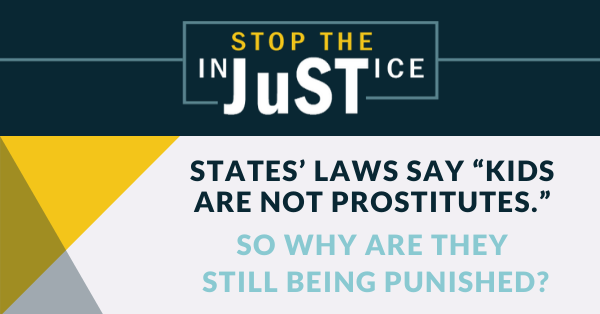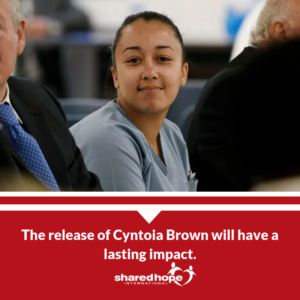By: Sarah Bendtsen and Christine Raino
While a relatively small percentage of children referred to and served by child welfare are child sex trafficking victims, child welfare has an important and unavoidable role in responding to child sex trafficking. Reformed and tailored responses to child sex trafficking are critical for ensuring proper responses to system-involved child sex trafficking survivors and reducing vulnerabilities to trafficking, which are often created or exacerbated by inappropriate child welfare responses. Moreover, when the child welfare system fails to respond appropriately to child sex trafficking victims or otherwise creates vulnerabilities to trafficking, research shows those failures disproportionately impact families of color.
Child welfare’s response specific to child and youth survivors of sex trafficking reflects a recent evolution in policy development, resulting in diverging practices and outcomes. While state and local agencies have long been serving young people impacted by maltreatment, including abuse, neglect, and exploitation, the role of child welfare has historically been limited to addressing maltreatment caused by a child’s parent or legal caregiver. The enactment of the Justice for Victims of Trafficking Act and Preventing Sex Trafficking and Strengthening Families Act of 2015, however, required a significant shift in child welfare’s response to both familial and non-familial cases of child sex trafficking. Together, these two pieces of federal legislation accelerated state and local policy change, resulting in many state statutory and regulatory reforms that sought compliance with new federal standards without full inclusion of best practices for this population. Consequently, many states continue to utilize traditional child welfare responses and practices for responding to the unique and complex needs of child sex trafficking survivors, including investigating non-offending caregivers or mandating the child and child’s family to participate in services. Such solutions, while well-intentioned, have only contributed to alarming racial and socio-economic disparities in system involvement and outcomes. However, emerging and thoughtful practices and laws are demonstrating how child welfare agencies can serve as a conduit to holistic wellbeing and support for child survivors and their community, rather than agencies focused on intervention, surveillance, and separation.
1.Historical and Current Practices
The development of formally recognized state child welfare agencies dates back to the enactment of the Social Security Act of 1935, which provided the first federal funding stream for the development of child protection and welfare services at the state and local levels. P.L. 74-271 appropriated $1.5 million annually “for the purpose of enabling the United States, through the Children’s Bureau,[1] to cooperate with State public welfare agencies in establishing, extending, and strengthening, in predominately rural areas, public [child] welfare services . . . for the protection and care of homeless, dependent, and neglected children, and children in danger of becoming delinquent.” Implementation of P.L. 74-271 and subsequent reauthorizations bolstered state child welfare agencies’ powers and provided necessary support and interventions for children experiencing maltreatment within the home; however, discriminatory practices also manifested early, resulting in harmful and biased treatment of families living in poverty, Indigenous communities, and children of single or unwed mothers.
Presently, Black and Indigenous communities, including children and youth, are involved in all systems, including child welfare, at much greater rates than their white counterparts. Of course, this is not because of racial identity but because of deeply entrenched systemic practices and structural responses to race, ethnicity, and socio-economic status. In addition to being reported, investigated, and subjected to abuse and neglect petitions in far greater and disproportional numbers than white families, families of color are also far less likely to receive meaningful economic and emotional supports that are proven to increase positive outcomes for the family and reduce or eliminate further system involvement or interventions.
2.Racial inequities & consequences
Examining the disproportional levels of interactions, interventions, and responses to families of color, it is unsurprising that both communities experience far greater negative short and long-term outcomes than white children who are child welfare involved. In addition to the trauma caused by child welfare investigations and ongoing surveillance, research demonstrates that Black, Indigenous, and Hispanic children are less likely to receive in-home services care, support, and resources than white children, often resulting in unnecessary removals and family separations. Once removed, Black children, more than any other community of children, are more likely to stay in foster or group home placement for longer periods of time, be subjected to multiple placements, and receive fewer services. Additionally, children and youth of color are significantly more likely to age out of the child welfare system rather than exit through family reunification or adoption and experience far worse outcomes in emerging adulthood, including housing insecurity, poverty, criminal justice system involvement, and unemployment. White children and families, who are subjected to child welfare interventions far less frequently, experience some of the same consequences and outcomes following system involvement for conduct that does not reflect actual abuse but, instead, is indicative of the family’s need for meaningful support and services, rather than investigation, ongoing surveillance, court-ordered services and evaluations, and potential separation. Consequently, children and families who may normally seek out and benefit from external support become distrustful of systems designed to support their wellbeing and are reticent to receive services.
3.Impact on CST survivors/families
Child sex trafficking has touched all communities regardless of race, socio-economic status, or geographical location. However, like system involvement, there are significant disparities in impact. Data on identified child sex trafficking victims continues to demonstrate the disproportional effect on children and youth of color. Recognizing the disparities in both experiences of exploitation and system involvement, it is especially critical that our anti-trafficking child welfare policies and practices account for the potential for unnecessary, system-induced harm and trauma. Responsible policymaking as it relates to the federally-mandated child welfare response to child and youth survivors must gravitate towards state-level policies that are culturally responsive and holistically supportive of the child and non-offending caregivers.
Emerging practices are demonstrating how child welfare agencies can be a conduit for support without entrenching trafficked youth and their families into a system that penalizes rather than supports. One alternative child welfare practice devised to avoid unnecessary investigations and interventions is the development of a “third track” avenue for assessing and serving child survivors of non-familial sex and labor trafficking. Virginia was the first state to enact legislation creating a human trafficking-specific assessment that focuses on evaluating the safety and services needs of the trafficked child without necessitating a traditional child abuse or neglect response. Relatedly, Minnesota has sought a similar policy change, seeking to utilize a non-caregiver sex trafficking assessment to focus on identifying the child and family’s service and safety needs, if any, without requiring an investigation into the child’s caregivers or a determination of maltreatment. In an effort to uncover and address systemic biases and consequences, Illinois state lawmakers are currently considering legislation which, if enacted, would create a pilot program to decrease the overrepresentation of children of color in out-of-home placements by requiring caseworkers to utilize a bias-free child removal strategy in making out-of-home determinations. Relatedly, in an effort to decrease unnecessary and traumatizing parent-child separations in cases of non-familial human trafficking, the California legislature is considering a bill which seeks to prohibit child welfare social workers from taking a child trafficking victim into temporary custody “unless continuance in the parent’s or guardian’s home is contrary to the child’s welfare . . . .”
Shared Hope, in a continued effort to identify and advocate for promising practices for responding to child and youth sex trafficking, is in full support of systems-level reforms that mitigate harm, trauma, and unnecessary involvement, particularly for communities and kids that are disproportionately impacted by the harmful outcomes of system involvement. In particular, in developing the Advanced Legislative Framework in 2020, we convened over 200 stakeholders from across the U.S. to identify best and emerging practices related to responses to child and youth sex trafficking. The guidance and feedback provided through this process, combined with information gathered through desk research and state technical assistance, informed a new state policy goal focused on reducing or eliminating traumatizing or punitive child welfare interventions for both the child and non-offending parents or caregivers. Resultantly, Shared Hope has adopted a policy position that seeks an alternative, collaborative, and strengths-based child welfare response to support non-offending parents without employing a traditional investigative abuse or neglect response. We invite you to join us in learning more about opportunities and solutions for increasing better outcomes for children and youth survivors of sex trafficking, including important modifications to child welfare practices and policies, by visiting our Report Cards on Child and Youth Sex Trafficking project page.
Action Items:
- Review Policy Issue Brief 2.11 which highlights the need for a modified child welfare response in cases of non-familial sex trafficking.
- Share a copy of your State Report Card with your state legislators.
- If you are a Minnesota resident, please consider contacting your state lawmakers and request their support for SF 1729/HF 1943, which would create and require use of a non-caregiver sex trafficking assessment for all reported cases of non-familial child sex trafficking.
[1] Established through P.L. 62-116 in 1912.









